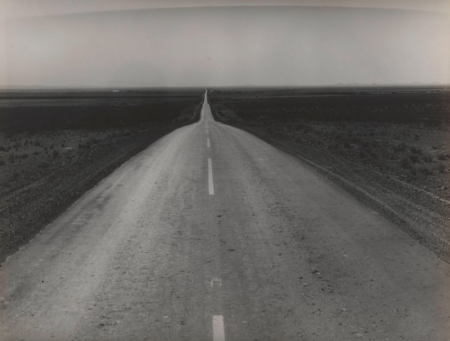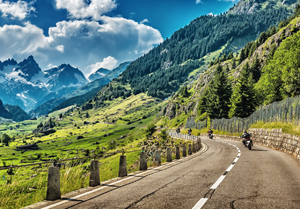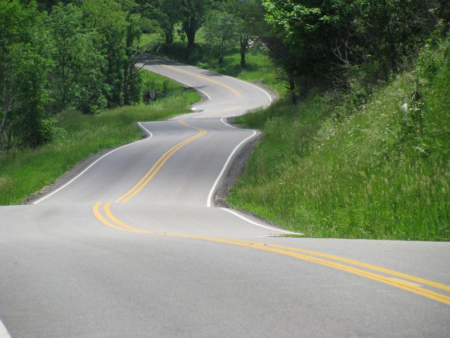Life and Island Times: Riders and the Road
Editor’s note: This is about back country roads and their motorcycle riders.
There is a difference between America’s western and eastern country roads. The latter are seacows compared to the tireless workhorse country roads of the west. When a rider hooks himself to a wonderful eastern road, challenge and thrill are certain but not the struggle and battle of those out west.
Why the difference? Perhaps it is the size of the western spaces, the height of the mountains, the depths of the sea, the total lack of civilization for long periods of space and time, the wide range of wild weather conditions. Regardless, the roads are different, if not in species, then in disposition.

Sometimes before changing conditions arrived on western roads, a faint smell or slight temperature change would hint at something new around the bend or over the hill. Rarely did the sounds of impending change announce with suitable warning time a serious challenge. When you heard this announcement loud and clear, you were already in the soup.
Once you were hooked in, you and and the road were on a run, sounding and rising, jumping and jerking about in a test of the machine and the man atop it. Few riders could resist a slight turn of the throttle to see how far and fast they could take this test.
Roads often fought back, making the riders work a man’s job. Riders must work mostly straight up with slight leans. Roads fought on their sides, unexpectedly moving side to side, up and down, bobbing and weaving, with hidden substances on their surfaces to trick and fail their would be conquerors with their heads down and intent on never stopping or slowing.
If a rider rested on the road while in battle, the road might rest too, but only to set the rider up. The road’s method might be a long, slow and gentle lift, then lower still to encourage the rider to crack the throttle further to wind the road in faster. When the road is reeled in like this, it might refuse to come in any faster or further beyond a certain point, creating a deadlock which could be fatal to a rider who tried to break it. Thus, western roads tried by guile and surprise to take the delusion and the fight out of its riders.
The best road for riders is the one when they are alone without other four-or-more-wheeled vehicles, all alone on a narrow pavement on a wide, wide rolling prairie.
The long, heaving hills, the windy lanes, the sideways flight of the rainwater and the uplifting wind microbursts from leviathan storms, the greyblack wall of night on the horizon, the leap of the spirit as a road was finally subdued, the sweet, soft scent that breathed from off the fields full of herbs and vegetables that would be in the market the next day, the beauty and mystery and color and movement of the road – these belong to riders alone, and they were as rich as if they had found the gravel of the road to be diamonds, its rainwater nectar, and its frost heaved, chipseal surface pure gold.
Happily, neither politics nor reality TV can intrude upon, let alone ruin, the wonders of the back country road. The sun and the fog, cold and heat, the rain and dust, the great, calm waters, the warm ocean currents, the pleasant and cyclonic winds — these elements all have their tasks, and they perform them faithfully, to the happiness of those who run these roads.
These untamed roads are free, careless, wholesome, restful, and serene. They are democratic and indifferent and aloof. These roads can be restless, like black threads in the new web that is America, and responding to the jerks and tremors of all the other threads in the country.
The country road does not suffer its riders idleness. They expect, encourage and demand their riders onward rush.
Back country byways do not pour their riders upon its places willy nilly. Their rider people are not impatient, like the big city world on wheels in its hurry to be somewhere else to be served, worked, bought or sold. Riders are the opposite of urban little animals in a cage, turning wire wheels, unable to stop.
Wonderful were the country road little breezes coming down the valleys, zephyrs filled with fruit trees scattered moisture from their leaves and rejoiced in the returning sunlight. Riders delighted in these roads’ wet and glimmering greenness. Sometimes these tarred roads steamed like the French dessert treats at a four star restaurant.
These out-of-the-way roads gave their riders feelings of great adventure, when their tarmac happened to be quiet. Riders propelled themselves as far and fast as they could towards the distant horizon. Adventure was unlimited and exploration extensive like that of a smiling and laughing toddler ambling over an endless green pasture.

Back country roads could be primitive creatures who deserved not just respect but propitiation and dread. Their beauty might give a rider sustenance, just as it might give him terror and death.
On the other hand, urban roads were different since they were often crowded with impersonal and relentless fragments of humanity. Their commuter hour crushes were like the tight links of the iron track of a caterpillar tractor or the steel scales of some tank tread. Their tremors and vibrations were just plain dangerous.
All riders have stories of commuter rushes when an unseeable squeal and scream seemed headed directly for them. A nameless terror would fall upon them. They were about to be crushed. Then came the silence that meant they had been pardoned once again.
Battles with urban roads were more like American revolutionary war skirmishes. Urban musketeer riders were rarely shot; but, when it occurred, it was likely deadly. There was no skill in this, just pure chance of the place and moment.
As these urban roads were under constant improvement, vehicles would come crawling to a halt and would then mambo along slowly ahead. The whole affair around America’s city centers was thus like a siege, with mine and counter-mine, trench and scarp.
These urban worlds were too built-up and too official for two wheeled riders to enjoy. There was no use grousing. To sell out and buy a nice McMansion shack in one of the nice new suburbs of the big city was not an answer. The ever present construction bumps on road surfaces weren’t considered obstacles those days. So much so, warning signs of bump presence were rare in urban settings.
Riders knew the secret of their vague discontent. They had rediscovered the immense possibilities outside of the selfieness of the city in what country folks vaguely call the spirit. They felt something under their scooters wheels on the road for which they had searched all their lives.
The vast accumulated experience of the urban world had, oddly enough, been admitted only to the surface of their minds, and had left little impression on their hearts.
Like a child who, with wonder and fascination, discovers that water is wet and that fire will burn, they began their investigations of the world where life’s vitality and the big things humans live by but cannot be analyzed in laboratories or learn in books.
The answer was easy for the riders, a simple formula to relax the mind, body and soul. It would rock in the cradle of their confidence. It would require more than a shred of attention to the details. They would sneak out onto the roads they knew and seek out the back country roads that they didn’t.
The urban driving public needed straight lines; riders would not.

Copyright © 2017 From My Isle Seat
